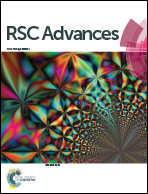Strongly-coupled PbS QD solids by doctor blading for IR photodetection†
Abstract
Solution-processed QD solids are emerging as a novel concept for high-performance optoelectronic devices. In this work, doctor blading is proposed for the fabrication of strongly-coupled QD solids from a PbS nanoink for photodetection at telecom wavelengths. The key step of this procedure is the solid-state ligand exchange, which reduces the interparticle distance and increases the carrier mobility in the resulting strongly-coupled QD solid. This is accomplished by replacing the original long oleylamine molecules by shorter molecules like 3-mercaptopropionic acid, as confirmed by FTIR, TGA and XPS. Further, a detailed investigation with XPS confirms the air-stability of the QD solids and the extreme reduction of the principal oxidation product, PbSO3, from ligand exchange times of 60 s. Finally, the QD solid is tested as an active layer for the fabrication of a Schottky NIR photodetector. The device shows a maximum responsivity of 0.26 A W−1 that corresponds to an internal quantum efficiency higher than 30% at 1500 nm and detectivity around 1011 jones.



 Please wait while we load your content...
Please wait while we load your content...